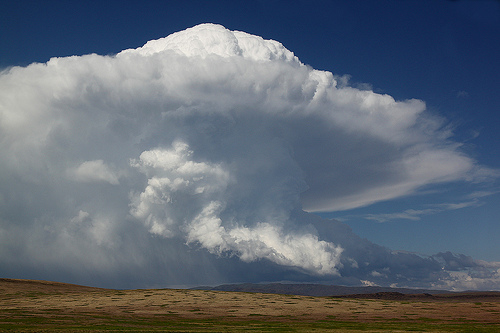Thunderstorm Hazards to Aviation
Learning Goal 4b. Identify thunderstorm hazards to flight & how
to avoid them. Details of these hazards are in Learning Goals
4c-h.
Hazards

Thunderstorms are convective clouds, which means they are driven by the buoyancy of warm rising air inside the cloud.
In North America, thunderstorms and their hazards are most common in Spring and Summer,
when warm humid air is triggered to rise along weather boundaries such
as cold fronts, sea breezes, dry lines, gust fronts, etc.
Click on the following links to get more details on these thunderstorm hazards to aviation:
|
Safety Recommendations for Flight near Thunderstorms
All aviation authorities require that you do NOT fly through thunderstorms. The US and Canada recommend that pilots stay at least 20 nautical miles away from thunderstorms.
Also, civilian pilots should NOT try to fly over the tops of
thunderstorms, because the storm can increase in thickness so fast that
the tops rise to engulf an aircraft trying to fly over it. Once
engulfed by the thunderstorm, the aircraft and pilot would likely
experience violent IFR weather conditions.
For pilots flying on instruments (IFR), air traffic controllers re-route aircraft to avoid the heaviest parts of the storm. This YouTube shows how landing traffic was re-routed, and sometimes put into race-track-shaped holding patterns, until the storm moved away from the Atlanta, Georgia airport: https://www.youtube.com/watch?v=eWv4wyy_Jqg
Keywords: ceiling, convective clouds, convective turbulence, downbursts, gust fronts, hail, heavy rain, icing, IFR, lightning, low-level wind shear, microbursts, precipitation static, thunderstorms, tornadoes, visibility
Extra info for experts; not needed for this course.
For safety recommendations, see:
CANADA
- Transport Canada Aeronautical Information Manual TC-AIM, see AIR chapter.
- AIR Section 2.7 Flight Operations near Thunderstorms
- AIR Section 2.8 Low Level Wind Shear
USA
- Federal Aviation Administration Aeronautical Information Manual (AIM). See Chapter 7.
- Section 7-1-28 Thunderstorms
- Section 7-1-29 Thunderstorm Flying
Image credits. Thunderstorm photo by Dr. Wolf Read, used with permission.